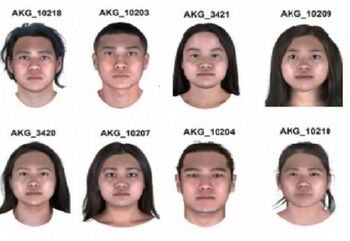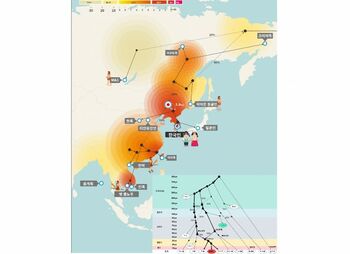Difference between revisions of "PageM3P1"
From PGI
| Line 8: | Line 8: | ||
삼국시대 한반도에 살았던 한국인은 현대 한국인과 상당히 닮았다는 분석이 나왔다. 삼국시대 한반도인의 유전체(게놈)을 처음으로 분석한 연구결과로 삼국시대 이후 한국인의 유전적 연속성이 큰 것으로 분석됐다. 울산과학기술원(UNIST)은 UNIST게놈센터, 국립중앙박물관, 국립김해박물관, 서울대, 게놈연구재단, 오스트리아 비엔나대, 클리노믹스 공동 연구를 통해 이같은 연구결과를 국제학술지 '커런트 바이올로지' 21일자(현지시간)에 발표했다고 밝혔다. 연구팀은 서기 300~500년 가야 지역 무덤 주인과 순장된 이들의 유골의 게놈을 분석했다. | 삼국시대 한반도에 살았던 한국인은 현대 한국인과 상당히 닮았다는 분석이 나왔다. 삼국시대 한반도인의 유전체(게놈)을 처음으로 분석한 연구결과로 삼국시대 이후 한국인의 유전적 연속성이 큰 것으로 분석됐다. 울산과학기술원(UNIST)은 UNIST게놈센터, 국립중앙박물관, 국립김해박물관, 서울대, 게놈연구재단, 오스트리아 비엔나대, 클리노믹스 공동 연구를 통해 이같은 연구결과를 국제학술지 '커런트 바이올로지' 21일자(현지시간)에 발표했다고 밝혔다. 연구팀은 서기 300~500년 가야 지역 무덤 주인과 순장된 이들의 유골의 게놈을 분석했다. | ||
</div> <div style="display: flex; margin-top: 6px;"><div style="font-size: 12px; line-height: 16px; color: rgb(55, 53, 47); white-space: nowrap; overflow: hidden; text-overflow: ellipsis;">[https://www.dongascience.com/news.php?idx=54949 https://www.dongascience.com/news.php?idx=54949]</div> </div> </div> <div style="flex: 1 1 180px; display: block; position: relative;"><div style="position: absolute; inset: 0px;"><div style="width: 100%; height: 100%;">[[File:Originface.jpg|350px|Originface.jpg]]</div> </div> </div> </div> </div> | </div> <div style="display: flex; margin-top: 6px;"><div style="font-size: 12px; line-height: 16px; color: rgb(55, 53, 47); white-space: nowrap; overflow: hidden; text-overflow: ellipsis;">[https://www.dongascience.com/news.php?idx=54949 https://www.dongascience.com/news.php?idx=54949]</div> </div> </div> <div style="flex: 1 1 180px; display: block; position: relative;"><div style="position: absolute; inset: 0px;"><div style="width: 100%; height: 100%;">[[File:Originface.jpg|350px|Originface.jpg]]</div> </div> </div> </div> </div> | ||
| + | |||
= 2020 = | = 2020 = | ||
| − | |||
| − | |||
<div style="display: flex;"><div class="notion-focusable" role="button" style="user-select: none; transition: background 20ms ease-in 0s; cursor: pointer; width: 100%; display: flex; flex-wrap: wrap-reverse; align-items: stretch; text-align: left; overflow: hidden; border: 1px solid rgba(55, 53, 47, 0.16); border-radius: 3px; position: relative; color: inherit; fill: inherit;"><div style="flex: 4 1 180px; padding: 12px 14px 14px; overflow: hidden; text-align: left;"><div style="font-size: 14px; line-height: 20px; color: rgb(55, 53, 47); white-space: nowrap; overflow: hidden; text-overflow: ellipsis; min-height: 24px; margin-bottom: 2px;">[https://www.dongascience.com/news.php?idx=37132 (게놈과 인류사)"한국인 주류, 남중국-동남아인의 복잡한 혼혈"]</div> <div style="font-size: 12px; line-height: 16px; color: rgba(55, 53, 47, 0.65); height: 40px; overflow: hidden;"> | <div style="display: flex;"><div class="notion-focusable" role="button" style="user-select: none; transition: background 20ms ease-in 0s; cursor: pointer; width: 100%; display: flex; flex-wrap: wrap-reverse; align-items: stretch; text-align: left; overflow: hidden; border: 1px solid rgba(55, 53, 47, 0.16); border-radius: 3px; position: relative; color: inherit; fill: inherit;"><div style="flex: 4 1 180px; padding: 12px 14px 14px; overflow: hidden; text-align: left;"><div style="font-size: 14px; line-height: 20px; color: rgb(55, 53, 47); white-space: nowrap; overflow: hidden; text-overflow: ellipsis; min-height: 24px; margin-bottom: 2px;">[https://www.dongascience.com/news.php?idx=37132 (게놈과 인류사)"한국인 주류, 남중국-동남아인의 복잡한 혼혈"]</div> <div style="font-size: 12px; line-height: 16px; color: rgba(55, 53, 47, 0.65); height: 40px; overflow: hidden;"> | ||
박종화 UNIST 교수팀이 한국인이 형성된 유전적 과정을 현대인 및 고대인 게놈 연구를 통해 새롭게 제시했다. 이에 따르면 수만 년 전부터 북아시아에 널리 퍼져 있던 동남아시아 유래 인류(선남방계)의 일부인 악마문동굴 신석기인이, 약 5000~4000년 전 남중국에서 동남아시아 및 동아시아 등지로 퍼져나간 새로운 인류(후남방계)와 만나 한국인의 조상을 형성한 것으로 나타났다. 다만 구체적인 인구집단의 이동 및 혼합 과정은 추가 연구가 필요할 것으로 보인다. 박종화 교수 제공 | 박종화 UNIST 교수팀이 한국인이 형성된 유전적 과정을 현대인 및 고대인 게놈 연구를 통해 새롭게 제시했다. 이에 따르면 수만 년 전부터 북아시아에 널리 퍼져 있던 동남아시아 유래 인류(선남방계)의 일부인 악마문동굴 신석기인이, 약 5000~4000년 전 남중국에서 동남아시아 및 동아시아 등지로 퍼져나간 새로운 인류(후남방계)와 만나 한국인의 조상을 형성한 것으로 나타났다. 다만 구체적인 인구집단의 이동 및 혼합 과정은 추가 연구가 필요할 것으로 보인다. 박종화 교수 제공 | ||
| − | </div> <div style="display: flex; margin-top: 6px;"><div style="font-size: 12px; line-height: 16px; color: rgb(55, 53, 47); white-space: nowrap; overflow: hidden; text-overflow: ellipsis;">[https://www.dongascience.com/news.php?idx=37132 https://www.dongascience.com/news.php?idx=37132]</div> </div> </div> <div style="flex: 1 1 180px; display: block; position: relative;"><div style="position: absolute; inset: 0px;"><div style="width: 100%; height: 100%;">[[File:News genome.jpg|350px|News genome.jpg]]</div> </div> </div> </div> </div> | + | </div> <div style="display: flex; margin-top: 6px;"><div style="font-size: 12px; line-height: 16px; color: rgb(55, 53, 47); white-space: nowrap; overflow: hidden; text-overflow: ellipsis;">[https://www.dongascience.com/news.php?idx=37132 https://www.dongascience.com/news.php?idx=37132]</div> </div> </div> <div style="flex: 1 1 180px; display: block; position: relative;"><div style="position: absolute; inset: 0px;"><div style="width: 100%; height: 100%;">[[File:News genome.jpg|350px|News genome.jpg]]</div> </div> </div> </div> </div> |
| − | |||
= 2018 = | = 2018 = | ||
Revision as of 09:49, 30 September 2022
언론보도
💡 게놈연구재단의 언론보도 자료를 기록합니다.
2022
2020
2018
https://www.news1.kr/articles/?3395827
https://cc.newdaily.co.kr/site/data/html/2018/08/10/2018081000093.html
https://newsis.com/view/?id=NISX20180810_0000387834&cID=10806&pID=10800








